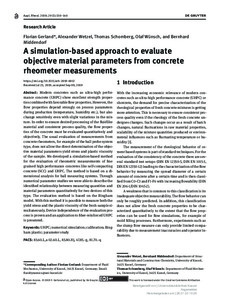A simulation-based approach to evaluate objective material parameters from concrete rheometer measurements
| dc.date.accessioned | 2020-01-28T10:17:10Z | |
| dc.date.available | 2020-01-28T10:17:10Z | |
| dc.date.issued | 2019-12-31 | |
| dc.identifier | doi:10.17170/kobra-20200128962 | |
| dc.identifier.uri | http://hdl.handle.net/123456789/11440 | |
| dc.description.sponsorship | Gefördert durch den Publikationsfonds der Universität Kassel | |
| dc.language.iso | eng | |
| dc.rights | Urheberrechtlich geschützt | |
| dc.rights.uri | https://rightsstatements.org/page/InC/1.0/ | |
| dc.subject | UHPC | eng |
| dc.subject | numerical simulation | eng |
| dc.subject | calibration | eng |
| dc.subject | Bingham plastic | eng |
| dc.subject | parameter study | eng |
| dc.subject.ddc | 530 | |
| dc.subject.ddc | 540 | |
| dc.title | A simulation-based approach to evaluate objective material parameters from concrete rheometer measurements | eng |
| dc.type | Aufsatz | |
| dcterms.abstract | Modern concretes such as ultra-high performance concrete (UHPC) show excellent strength properties combined with favorable flow properties. However, the flow properties depend strongly on process parameters during production (temperature, humidity etc.), but also change sensitively even with slight variations in the mixture. In order to ensure desired processing of the fluidlike material and consistent process quality, the flow properties of the concrete must be evaluated quantitatively and objectively. The usual evaluation of measurements from concrete rheometers, for example of the ball probe system type, does not allow the direct determination of the objective material parameters yield stress and plastic viscosity of the sample. We developed a simulation-based method for the evaluation of rheometric measurements of fine grained high performance concretes like self-compacting concrete (SCC) and UHPC. The method is based on a dimensional analysis for ball measuring systems. Through numerical parameter studies we were able to describe the identified relationship between measuring quantities and material parameters quantitatively for two devices of this type. The evaluation method is based on the Bingham model. With this method it is possible to measure both the yield stress and the plastic viscosity of the fresh sample simultaneously. Device independence of the evaluation process is proven and an application to fiber-reinforced UHPC is presented. | eng |
| dcterms.accessRights | open access | |
| dcterms.creator | Gerland, Florian | |
| dcterms.creator | Wetzel, Alexander | |
| dcterms.creator | Schomberg, Thomas | |
| dcterms.creator | Wünsch, Olaf | |
| dcterms.creator | Middendorf, Bernhard | |
| dc.relation.doi | doi:10.1515/arh-2019-0012 | |
| dc.type.version | publishedVersion | |
| dcterms.source.identifier | ISSN 1617-8106 | |
| dcterms.source.issue | Heft 1 | |
| dcterms.source.journal | Applied Rheology | eng |
| dcterms.source.pageinfo | 130-140 | |
| dcterms.source.volume | Band 29 |
Files in this item
This item appears in the following Collection(s)
-
Artikel [1103]

